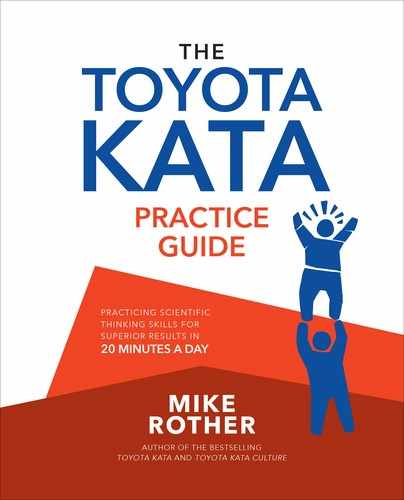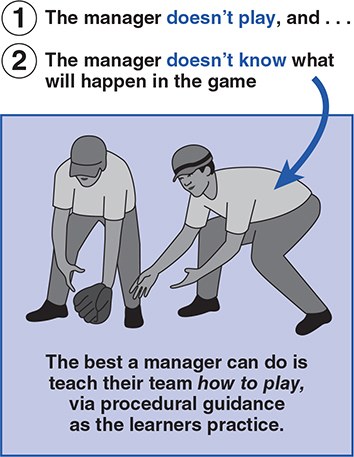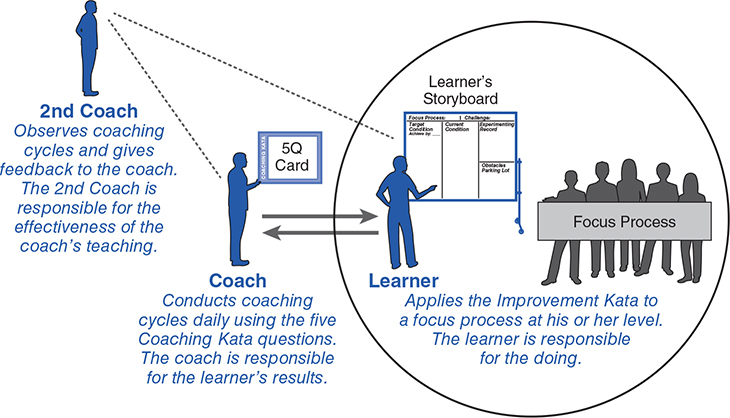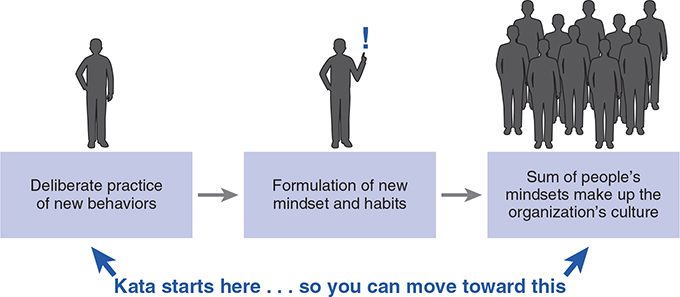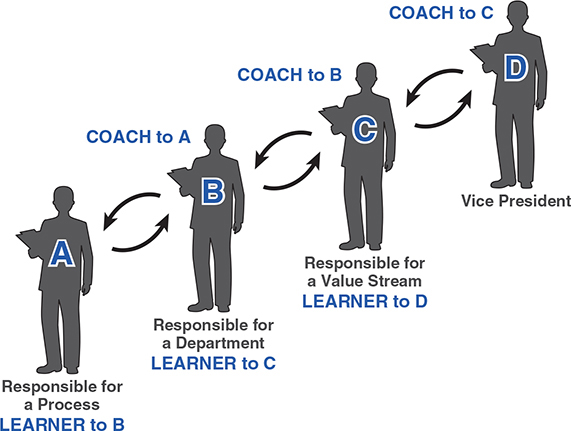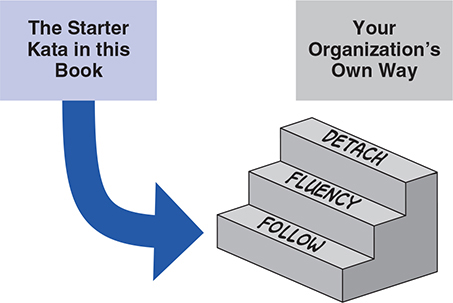CHAPTER 3
ROLES AND STRUCTURE FOR DAILY PRACTICE
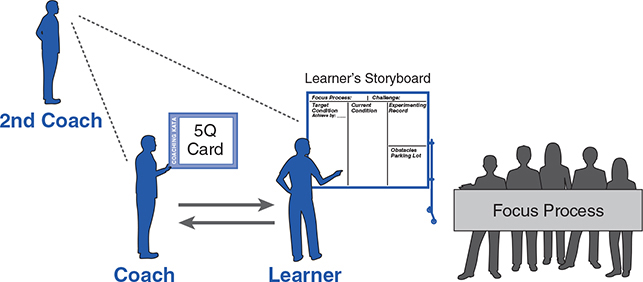
Managers as Coaches
How do you create an aligned, scientific thinking organizational culture?
Organizational culture is mindset imparted by our experiences at work, and modifying the culture involves changing the environment and deliberately practicing new behaviors. The culture shifts when enough people in the organization do the organization’s work in the new ways. This suggests that practicing and coaching to modify an organization’s culture should be systemic—integrated into the normal daily operation of the organization. The Improvement Kata and Coaching Kata are exactly that—a process to develop scientific skills and mindset in people through the work itself.
In any organization, the managers are by default the teachers—the coaches in our case—because what they say and do every day, deliberately or not, trains and shapes their people’s thinking. Manager here refers to any person who is in charge of other people or influences what they do. Managers are probably the primary actors who spread and perpetuate an organization’s culture. Ideally, what managers say and do reinforces the organization’s desired way of thinking and acting every day, to help create and preserve whatever organizational culture and capability you want.
The center of a modern society, economy and community is not technology. It is not information. It is not productivity. It is the managed institution as the organ of society to produce results. And management is the specific tool, the specific function, the specific instrument to make institutions capable of producing results.
—Peter Drucker
Management Challenges for the 21st Century
(HarperBusiness, 2001)
Two Core Roles in Daily Kata Practice: Learner and Coach
The coach/learner relationship is at the root of the Improvement Kata approach to developing a scientific thinking mindset.1 In an organization, the learner and coach roles usually mirror a reporting relationship, with the coach being the learner’s manager, although there can be exceptions, such as peer coaching or coaching by a specialist. Most important is that the coach has some experience in applying the Improvement Kata pattern.
Many managers have been conditioned by their work to be oriented toward ad hoc action—deciding what must be done and issuing sets of directions. Some call this “firefighting.” The Improvement Kata is a different way of pursuing goals, where what is learned on one day is built upon the next day. The scheduled daily coaching cycles are a cue for both the learner and the coach to pause and use the five Coaching Kata questions to reflect on the last step, review the plan for the next step, and to practice their respective skills. During the coaching cycles the learner and coach each focus on a different aspect, with the learner working on the steps to the target condition (the what) while the coach works on how the learner is approaching it. During the entire practice process the following two aspects happen simultaneously:
![]() There is an improvement goal. The learner’s main goal is to effectively apply the pattern of the Improvement Kata to achieve a target condition at the learner’s level in the organization. The learner improves their focus process through application of the scientific Improvement Kata pattern, in the direction of the challenge.
There is an improvement goal. The learner’s main goal is to effectively apply the pattern of the Improvement Kata to achieve a target condition at the learner’s level in the organization. The learner improves their focus process through application of the scientific Improvement Kata pattern, in the direction of the challenge.
![]() There is a skill-development goal. The coach’s main goal is to increase the learner’s skill in applying the Improvement Kata pattern, through practice on real goals and real processes. The coach guides the thinking process, not the content, of the learner’s actions, by asking questions and giving procedural guidance. The coach’s focus is on developing the learner’s ability to meet challenging objectives, by guiding the learner in practicing the Improvement Kata pattern. This grows the organization’s internal capability to establish and pursue challenging, strategically relevant goals.
There is a skill-development goal. The coach’s main goal is to increase the learner’s skill in applying the Improvement Kata pattern, through practice on real goals and real processes. The coach guides the thinking process, not the content, of the learner’s actions, by asking questions and giving procedural guidance. The coach’s focus is on developing the learner’s ability to meet challenging objectives, by guiding the learner in practicing the Improvement Kata pattern. This grows the organization’s internal capability to establish and pursue challenging, strategically relevant goals.
Although they each have a different focus, the coach and learner roles are interdependent. This is a subtle but important point. The coach is dependent on the learner to make progress toward the target condition, yet can only give the learner procedural guidance, not solutions. That’s because no one knows in advance what solutions will lead to the target condition. The learner, in turn, is dependent on the manager to coach him or her effectively for skill development.2
Here’s a way to look at it. The coach/manager can’t play in the game himself and therefore needs the learner to play successfully, otherwise the organization’s goals won’t be met (Figure 3.1). Sometimes a learner might not reach the next target condition, or might not reach it on time. That’s normal. However, if a learner consistently fails to reach target conditions, it is actually the coach who is responsible, because if a student hasn’t learned, their teacher hasn’t taught. In an elegant way, the coach is as dependent on the learner as the learner is on the coach. They’re in it together.
Figure 3.1. The manager is responsible for making his or her people successful.
When we see famous athletes, we may assume that their success is due to themselves, but their coach plays a key role. The coach’s job is not only difficult, it is often out of view and less heralded than that of learners who successfully reach their target conditions.
A Third Role: The Second Coach
Since coaches are practicing a skillset too, they also need a coach (Figure 3.2). The second coach coaches the first coach and is responsible for the effectiveness of the first coach’s coaching. The second coach does this by periodically observing coaching cycles and giving feedback and suggestions to the coach. The second coach is either the coach’s boss, one level up in the hierarchy from the coach, or a peer or a staff specialist, such as a Lean staff person. Like the coach, the second coach should have personal experience with applying the Improvement Kata. The second coach role is discussed at the end of Part III.
Figure 3.2. Quick descriptions of the three main roles in Improvement Kata practice.
Two Supporting Roles for Improvement Kata Practice
For the additional players mentioned below, it is helpful to think of the supporting staff truism that the learner’s and coach’s success is these players’ success. That is, the organization delivers sustained value, achieves goals, and continuously improves primarily through the activities of its managers and their teams.
Lean or Improvement Team Staff Members, Human Resources
Since developing people is every manager’s responsibility, the Lean or improvement team staff is primarily a service-and-support function to help managers be successful. The Lean staff should influence managers and try to operate through them, not try to improve work processes separately from them. They can do this, for example, by training, observing, and coaching managers as those managers in turn coach Improvement Kata application practice. If staff functions take over the role of training Improvement Kata learners, they dilute the managers’ responsibility for developing their people.
However, directly moving Lean staff members to a second coach role does not work well if they do not have experience in applying the Improvement Kata. They should be encouraged to start by practicing the Improvement Kata themselves.
External Consultants
The role of an external coach is to help selected persons in your organization develop Coaching Kata proficiency as quickly and effectively as possible, so those persons can then teach and spread the Improvement Kata within the organization with decreasing reliance on outside expertise. An external coach is used more at the beginning than later. It is important that any presentations, training, and coaching related to the Improvement Kata be done by persons inside your organization as soon as possible, because the act of teaching also develops the teacher’s skills. The role of the external coach is to help you get started and to support you, not to do your presenting/coaching/training for you, as that would prevent you and your organization from developing the necessary skills.
There is also a role for an external coach to come in periodically, assess the organization, and provide an external benchmark.
Conducting Coaching Cycles on a Set Schedule
For each learner, you’ll be scheduling a regular coaching cycle at a set time near the start of the workday or shift. The first coaching cycle should be early in the day so the learner can take the next step that day if possible. Companies that use coaching cycles often establish a “Kata time zone,” for example from 9 to 11 a.m., during which managers don’t do e-mail, attend meetings, or make phone calls.
After the regular coaching cycle, the coach and learner can decide if they want or need to do any additional coaching cycles that day. With beginner learners, try to do a coaching cycle soon after each step the learner takes, so that feedback is received quickly and corrections are made right away. Once learners have become proficient they can then take multiple or more complex steps without needing a coaching input each time.
On a case-by-case basis the coach can also decide to accompany the learner, especially beginners, as the learner takes the next step, to observe the learner in action and provide additional coaching outside of the formal coaching cycle.
At this point it might seem like coaching the Improvement Kata is going to be a time-consuming add-on that eats up every day and is all that anyone is doing. Experience has shown the opposite. Practicing a scientific way of working reduces the amount of time a manager would otherwise spend on firefighting, unstructured meetings, additional dialogues, and unnecessary problem solving. As your coaching skill develops you should start to experience better results with less energy and time.
With practice, each coaching cycle takes 20 minutes or less, since each cycle is only about reviewing the last experiment and checking that the next experiment will advance learning. The coaching cycles are not for planning the next experiment from scratch or for doing the experimenting itself, although the proposed next experiment may be revised based on what is discussed.3 In a coaching cycle the learner and coach identify the current threshold of knowledge and agree on the learner’s next experiment to see beyond it. That’s it. The learner’s experiments and planning of the next step then take place between the coaching cycles.
If You Don’t Have any Improvement Kata Coaches Yet . . . You Can Rotate Roles for Practice Purposes!
Getting to the point where managers are Improvement Kata coaches is an important element of being able to coach learners every day. However, at the start you may not have enough, or even any, Improvement Kata experienced managers. How do you coach learners in that situation?
One approach to dealing with a lack of internal experienced coaches is to find an experienced external coach/consultant to coach some managers in getting started. Those managers start as learners of the Improvement Kata and then grow into the coach role.
Another temporary solution for getting started is to have people practice in rotation, whereby each person in turn takes the role of learner, coach, and second coach—at the start in name only. You literally change positions relative to the storyboard, as shown in the following examples. These rotation models are temporary, artificial structures for daily practice, to as quickly as possible develop some Improvement Kata and Coaching Kata experience and capability. They generally last for six to eight weeks of practice (for example, through three successive target conditions). All other guidelines for coaching cycles stay the same, including that they are scheduled at a set time early in the day.
Example 1: Daily Role Rotation. If you have three persons who want to practice but you don’t have a coach, you can use this daily rotation model. Each member of the practice team is a learner applying the Improvement Kata to a different focus process, is coached by a designated member of the team, and you do each rotation every day. You can also add a fourth person and fourth focus process, by having two persons take the role of second coach (observer) in each rotation.
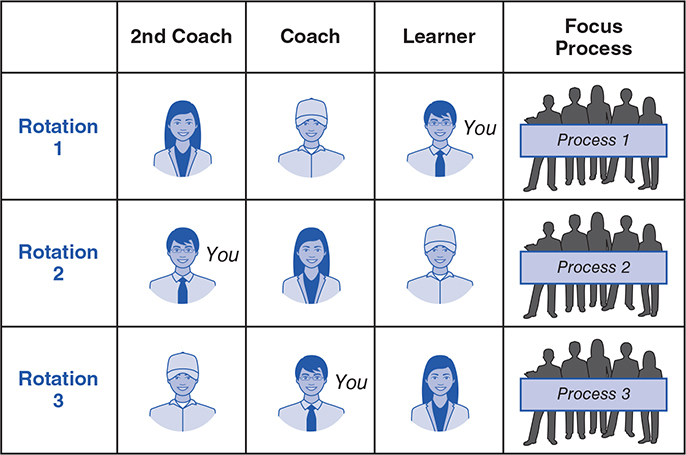
Example 2: Periodic Role Rotation. In this rotation model the members of one practice team all use the same focus process and periodically rotate their roles within their team, for instance rotating roles every 10 coaching cycles. Here, too, you can add a fourth person to a practice team by having two persons take the role of second coach.

Summary
This chapter discussed the coach/learner roles and coach/learner interactions in daily coaching cycles, which is the essential structure at the base of Improvement Kata practice. The Toyota Kata Practice Guide is for a learner and a coach—the fundamental unit of deliberate practice. At this point you can get going with Improvement Kata practice, and the short next chapter prepares you for that.
In the box on the following pages we widen the perspective for a moment, to take a look at how the base coach/learner pairing can be multiplied and deployed throughout an organization, with the intent of generating scientific thinking organizational culture.
1 This book refers to Coach and Learner. Some organizations use terminology like Mentor and Mentee or Coach and Coachee.
2 In sports and music, a learner can often choose their teacher, but in business learners usually can’t choose their manager. All the more reason to ensure that the managers in your organization are teaching what you want people to be learning.
3 It will probably take some practice before you can consistently do a coaching cycle in 10 to 20 minutes.
4 This topic is the subject of the book Toyota Kata Culture (McGraw-Hill, 2017).
5 A fractal is something that has the same or similar pattern that repeats at each scale level.
6 Some organizations even call this team the “shepherding group.”
